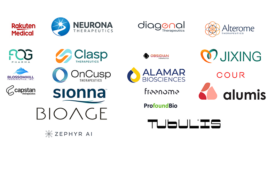
[ipopba/Adobe Stock]
Biotech resilience emerging as a theme, but ‘flawless execution’ a need
“JPM underscored the resilience of biotechs amid economic challenges, emphasizing strategic priorities like bringing assets into the clinic and an unwavering commitment to timelines,” said Meri Beckwith, co-founder Lindus Health, a CRO running end-to-end clinical trials. “The industry’s pragmatic shift recognizes the crucial role of end-to-end execution in clinical studies, from meticulous design to proficient project management.”

Kathy Ku
Many conversations at the event focused on companies that executed well despite budget constraints, provided immediate ROI, and efficiently integrated with buyers’ systems, said Dr. Kathy Ku, senior associate at Vive Collective. “In today’s landscape, flawless execution throughout the entire clinical trial journey is paramount for successful adaptation,” Ku said.
As Ku stated, in this era the true value of healthcare enterprises is measured by tangible, proven outcomes rather than just potential. Other Discussions at the event also centered around reasonable growth expectations for healthcare verticals and investors’ responsibility in evaluating portfolio companies’ success, Ku said. “On the flip side, investors can also bear some of the responsibility for evaluating the success of the companies they own,” she continued. “There were other discussions around what it means to be a venture backable healthcare business and whether it is reasonable for investors to anticipate hockey stick growth in specific healthcare verticals.”

Guy Friedman
This shift in perspective towards more realistic growth and success measures in healthcare investments is also reflected in the operational strategies of companies within this sector, said Guy Friedman, CEO and co-founder of SteadyMD, a B2B telehealth infrastructure provider. “Companies are tightening up, buckling down, and focusing on what they’re good at,” Friedman said.
Novel technologies and approaches on display

Meri Beckwith
At JP Morgan, several companies highlighted new developments in genomics, precision medicine, and early cancer detection. Examples include Natera’s personalized and predictive oncology testing. Companies like 1910 Genetics touted computational biology and automated lab technologies to enhance R&D efficiency while companies like Caribou Biosciences and Eligo Bioscience highlighted unique uses of CRISPR, with Caribou focusing on cell therapies and Eligo on microbiome editing.
Eligo up close: Targeting acne with precision microbiome gene editing
Eligo Bioscience, founded in 2014 out of MIT and Rockefeller University, is using CRISPR technology to precisely edit bacteria involved in diseases such as acne while preserving the rest of the microbiome. “We first discovered that when you deliver nucleases to bacteria and create a double-stranded break in the chromosome of the bacteria, the bacteria cannot repair the double-strand breaks and therefore die,” said Xavier Duportet, CEO of Eligo Bioscience. “This led us to the idea of using this technology to precisely target and eliminate bacteria that have genes involved in disease, while leaving the rest of the microbiome completely intact.”

Xavier Duportet
The company is developing a topical agent known as EB005, intended to treat moderate to severe forms of acne. This approach uses CRISPR gene editing to selectively target and remove bacteria in the skin’s microbiome that express pro-inflammatory molecules. By precisely altering these specific bacterial strains, EB005 aims to effectively address the underlying causes of acne without disrupting the beneficial bacteria in the skin. “It gets into the bacteria. And once inside the bacteria, nucleases are expressed, which reprogram and target specific genes that are unique to acne-associated strains,” Duportet said. “The outcome of the treatment will specifically target and eliminate the harmful bacterial strains, while leaving the beneficial ones completely intact.” The treatment then will allow beneficial bacteria to recover and expand their numbers, contributing to a healthy microbiome.
Of course, AI was another notable technology at the conference, with AI-focused firms announcing partnerships with Big Pharma. Isomorphic Labs, part of Alphabet, announced partnerships with Novartis and Eli Lilly to use its AlphaFold technology for discovering and designing new small molecules. NVIDIA meanwhile continued to expand its presence in the biotech sector through renewed collaborations with Amgen and Deepcell, focusing on applying its generative AI technology in areas such as drug discovery and cell morphology analysis.
Renewed interest in ADCs
The surging interest in antibody-drug conjugates (ADCs) was evident at the 2024 JPMorgan Healthcare Conference, which highlighted the drug class as a key area of innovation in oncology. JPMorgan’s 2023 Biopharma Licensing and Venture Report, released ahead of the conference, recorded a $128.8 billion in total biopharma acquisitions for 2023. Of these, AbbVie’s acquisition of Immunogen for $10 billion was a notable acquisition. In addition, Johnson & Johnson’s announcement of a $2 billion acquisition of ADC company Ambrx during the conference and Pfizer’s recently completed acquisition of Seagen underscored the ongoing commitment of Big Pharma to this sector.

Dr. Chris Bardon
“ADCs were obviously the rage last year,” said Dr. Chris Bardon, co-managing partner of the biotech investing firm MPM BioImpact. Bardon points to the success of ‘ENHERTU (fam-trastuzumab deruxtecan-nxki), Daichi Sankyo’s flagship drug, which has won approvals for a variety of cancer indications, including HER2-positive breast cancer, non-small cell lung cancer, and gastroesophageal junction adenocarcinoma. In 2023, the drug, which AstraZeneca jointly developed with Daiichi Sankyo, whose global sales could hit $9.9 billion by 2029. Its indications have expanded to include not just specific cancer types, but also more general HER2-positive solid tumors.
The role of ENHERTU in reshaping the ADC landscape
While early generation ADCs provided limited efficacy duration, Bardon notes that ENHERTU has “transformed how we think of ADCs” through its exceptional clinical activity – eliciting responses even in patients previously deemed HER2-negative. Third-generation ADCs such as ENHERTU have significant advances in linker and payload technology, as well as in the specificity and efficiency of the antibody component.
Bardon describes ENHERTU as not just an incremental advance, but a “transformative” drug that has achieved unprecedented outcomes across the HER2-positive cancer landscape. In the past, clinicians tended to view ADCs as a drug class that could provide benefits for a matter of months. Now, ENHERTU helped reshape this view, demonstrating potential for longer-term disease control and even substantial tumor regression in various cancer types.
Big Pharma companies are shifting their acquisition strategies as a result of the success of the drug class, focusing on developing new targets for new disease areas using advanced ADC technologies. “Now that the technology is a little bit more stabilized, people aren’t going to buy platforms anymore,” Bardon said. That is, they are likely to take a more selective approach, prioritizing specific ADC-related drugs or technologies.
Obesity drug momentum continues but GLP-1 fatigue sets in
A flock of companies are aiming to find the “next GLP-1,” building on the success of Novo Nordisk and Eli Lilly. Still, the rash of attention has prompted some investor fatigue in GLP-1s, as Truist recently explained in a briefing note. But the field of anti-obesity medications is also becoming complex. Emerging collaborations between companies indicate a research paradigm focused on more upstream obesity strategies using genomics and epigenetics.
One example of this diverse approach comes courtesy of Lilly-allied Fauna Bio, which is applying its Convergence AI platform to proprietary genomic and other omic data from 13-lined ground squirrels and other animal species. Fauna notes that hibernating ground squirrels exhibit “extreme physiology” in their annual weight gain and loss cycle, making them a promising model for understanding obesity pathways. These ground squirrels double their body weight before hibernation and then draw on fat stores during hibernation without suffering from metabolic diseases such as diabetes or cardiac damage. It goes without saying though that humans are not ground squirrels, and challenges persist in translating these animal model findings into safe and effective human therapies.
Filed Under: Biotech, Data science, machine learning and AI




